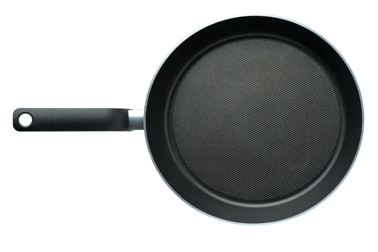 By TreeLiving There may be a few people out there who enjoy scrubbing pots and pans, but most of us will embrace anything that makes this tedious task easier. There’s a reason why, back in 1961, the first non-stick frying pan on sale in the United States was called ‘The Happy Pan’. Half a century later, there are fewer reasons to be happy about non-stick cookware, as potential health hazards have come to ligh t. If you want to keep a green home, then it’s probably something you’ll want to think twice about. The secret of non-stick cookware is the Teflon coating. Teflon is a trade name owned by the Du Pont chemical company. Teflon (or Tefal) may be one of several thermoplastic polymers. Polytetrafluoroethylene (PTFE) is the one most commonly used. It consists of carbon and fluorine molecules. The low friction coefficience and water repellence of Teflon coating is what makes it an easy to clean option for kitchen utensils – but that labor-saving advantage is not without a downside. Teflon is tough stuff that is stable at lower temperatures, but it does start to deteriorate at high heat, of about 500º F (260º C). At very high temperatures (higher than 350 °C, or 662 °F) it starts to decompose. Typical temperatures for frying food do not usually exceed 230 °C (446 °F). However, if a pan is allowed to overheat or burn (especially if heated when empty), then toxic substances known as perfluorinated chemicals (PFCs) can be given off. It’s easy to do, as experiments have shown, and yet relatively few people are aware of the danger that Teflon cookware can pose to humans and animals alike. Scientists have dubbed the effects of PFC emissions ‘Teflon flu’ or ‘polymer fume fever’. The PFC fumes can cause serious lung contamination and dysfunction. The symptoms of polymer fume fever include flu-like respiratory symptoms, fever and headache. The PFC vapors are highly dangerous for birds, whose respiratory systems are especially vulnerable to the toxic chemicals. Also of concern to environmental health experts and campaigners is a substance used as a surfactant in non-stick pans. Perfluorooctanoic acid has raised suspicions, and manufacturers have agreed to limit, but not eliminate, the use of this chemical in cookware manufacture. If you want to maintain a green home and healthy lifestyle, then there are plenty of alternatives to non-stick pots, pans and baking trays. Cast iron cookware has been described as naturally non-stick, and it will last you the better part of a lifetime. Stainless steel is also easy to clean. Putting hot water into pots straight after use makes residues easy to remove. If you have to spend an extra couple of minutes scrubbing your pots, it’s worth it in terms of a green home and your wellbeing.
By TreeLiving There may be a few people out there who enjoy scrubbing pots and pans, but most of us will embrace anything that makes this tedious task easier. There’s a reason why, back in 1961, the first non-stick frying pan on sale in the United States was called ‘The Happy Pan’. Half a century later, there are fewer reasons to be happy about non-stick cookware, as potential health hazards have come to ligh t. If you want to keep a green home, then it’s probably something you’ll want to think twice about. The secret of non-stick cookware is the Teflon coating. Teflon is a trade name owned by the Du Pont chemical company. Teflon (or Tefal) may be one of several thermoplastic polymers. Polytetrafluoroethylene (PTFE) is the one most commonly used. It consists of carbon and fluorine molecules. The low friction coefficience and water repellence of Teflon coating is what makes it an easy to clean option for kitchen utensils – but that labor-saving advantage is not without a downside. Teflon is tough stuff that is stable at lower temperatures, but it does start to deteriorate at high heat, of about 500º F (260º C). At very high temperatures (higher than 350 °C, or 662 °F) it starts to decompose. Typical temperatures for frying food do not usually exceed 230 °C (446 °F). However, if a pan is allowed to overheat or burn (especially if heated when empty), then toxic substances known as perfluorinated chemicals (PFCs) can be given off. It’s easy to do, as experiments have shown, and yet relatively few people are aware of the danger that Teflon cookware can pose to humans and animals alike. Scientists have dubbed the effects of PFC emissions ‘Teflon flu’ or ‘polymer fume fever’. The PFC fumes can cause serious lung contamination and dysfunction. The symptoms of polymer fume fever include flu-like respiratory symptoms, fever and headache. The PFC vapors are highly dangerous for birds, whose respiratory systems are especially vulnerable to the toxic chemicals. Also of concern to environmental health experts and campaigners is a substance used as a surfactant in non-stick pans. Perfluorooctanoic acid has raised suspicions, and manufacturers have agreed to limit, but not eliminate, the use of this chemical in cookware manufacture. If you want to maintain a green home and healthy lifestyle, then there are plenty of alternatives to non-stick pots, pans and baking trays. Cast iron cookware has been described as naturally non-stick, and it will last you the better part of a lifetime. Stainless steel is also easy to clean. Putting hot water into pots straight after use makes residues easy to remove. If you have to spend an extra couple of minutes scrubbing your pots, it’s worth it in terms of a green home and your wellbeing.
Why You Should Avoid Non-stick Cookware

